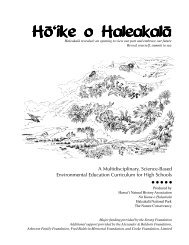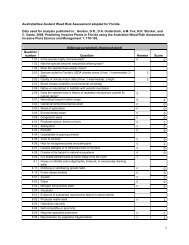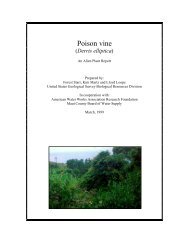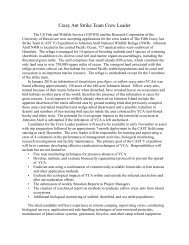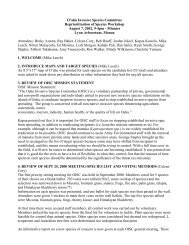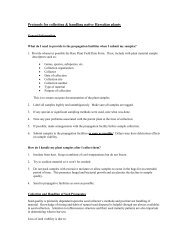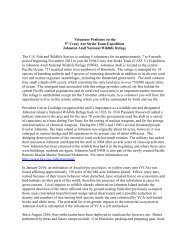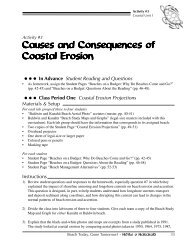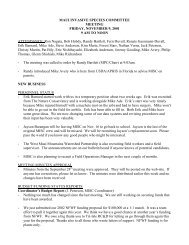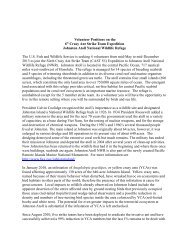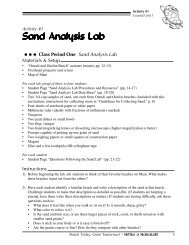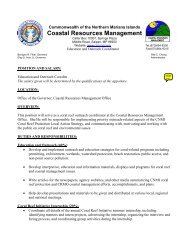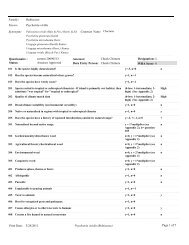Report to the Republic of Palau: 2008 update on Invasive Plant ...
Report to the Republic of Palau: 2008 update on Invasive Plant ...
Report to the Republic of Palau: 2008 update on Invasive Plant ...
You also want an ePaper? Increase the reach of your titles
YUMPU automatically turns print PDFs into web optimized ePapers that Google loves.
Australia). Its weed risk assessment classifies it as “high risk” with a score <str<strong>on</strong>g>of</str<strong>on</strong>g> 13, but we have<br />
not observed it being a problem <strong>on</strong> <str<strong>on</strong>g>Palau</str<strong>on</strong>g> or <strong>on</strong> o<str<strong>on</strong>g>the</str<strong>on</strong>g>r Pacific islands outside <str<strong>on</strong>g>of</str<strong>on</strong>g> Hawai‘i.<br />
The African oil palm (Elaeis guineensis) is present <strong>on</strong> Koror and present and reproducing <str<strong>on</strong>g>to</str<strong>on</strong>g><br />
some extent <strong>on</strong> Babeldaob. It has a risk assessment score <str<strong>on</strong>g>of</str<strong>on</strong>g> 9, “high risk”, and thus should be<br />
m<strong>on</strong>i<str<strong>on</strong>g>to</str<strong>on</strong>g>red for spread.<br />
Episcia cupreata (episcia, flame violet) is widely cultivated but is also growing wild <strong>on</strong> rock<br />
walls and in <str<strong>on</strong>g>the</str<strong>on</strong>g> forest unders<str<strong>on</strong>g>to</str<strong>on</strong>g>ry, especially in Koror State. It has a risk assessment score <str<strong>on</strong>g>of</str<strong>on</strong>g> 3<br />
so it warrents m<strong>on</strong>i<str<strong>on</strong>g>to</str<strong>on</strong>g>ring for spread.<br />
Hemigraphis alternata (metal leaf, red ivy), introduced as an ornamental, is present in dense low<br />
stands at several locati<strong>on</strong>s, sometimes invading under <str<strong>on</strong>g>the</str<strong>on</strong>g> forest canopy. Although rated “low<br />
risk” with a risk assessment score <str<strong>on</strong>g>of</str<strong>on</strong>g> 1, it is shade <str<strong>on</strong>g>to</str<strong>on</strong>g>lerant, spreads in <str<strong>on</strong>g>the</str<strong>on</strong>g> forest unders<str<strong>on</strong>g>to</str<strong>on</strong>g>ry over<br />
time and can exclude o<str<strong>on</strong>g>the</str<strong>on</strong>g>r species.<br />
Hyptis capitata (knobweed) is widely distributed <strong>on</strong> Babeldaob, Koror, Malakal and<br />
Ngerkebesang. It is quite invasive al<strong>on</strong>g roads and in disturbed areas and has a score <str<strong>on</strong>g>of</str<strong>on</strong>g> 17 from<br />
a weed risk assessment prepared in Australia.<br />
Inga edulis (ice cream bean) is a tree that is becoming invasive in nor<str<strong>on</strong>g>the</str<strong>on</strong>g>rn Queensland. An<br />
example was seen in 2002 growing in fr<strong>on</strong>t <str<strong>on</strong>g>of</str<strong>on</strong>g> <str<strong>on</strong>g>Palau</str<strong>on</strong>g> Community College. It has a weed risk<br />
assessment score <str<strong>on</strong>g>of</str<strong>on</strong>g> 2, “evaluate fur<str<strong>on</strong>g>the</str<strong>on</strong>g>r”. The identificati<strong>on</strong> <strong>on</strong> this tree should be checked as it<br />
may be I. feuillei.<br />
Murraya paniculata (orange jessamine, mock orange, satin-wood, Chinese box) is cultivated as<br />
an ornamental plant. It has bird-dispersed seeds and thus <str<strong>on</strong>g>the</str<strong>on</strong>g> ability <str<strong>on</strong>g>to</str<strong>on</strong>g> spread and has a weed<br />
risk assessment score <str<strong>on</strong>g>of</str<strong>on</strong>g> 6 (evaluate fur<str<strong>on</strong>g>the</str<strong>on</strong>g>r). However, it has not been observed as invasive <strong>on</strong><br />
<str<strong>on</strong>g>the</str<strong>on</strong>g> Pacific islands where it is present. In Asia M. paniculata is <str<strong>on</strong>g>the</str<strong>on</strong>g> preferred host <str<strong>on</strong>g>of</str<strong>on</strong>g> <str<strong>on</strong>g>the</str<strong>on</strong>g> insect<br />
pest Diaphorina citri, <str<strong>on</strong>g>the</str<strong>on</strong>g> citrus psyllid. The psyllid is <str<strong>on</strong>g>the</str<strong>on</strong>g> vec<str<strong>on</strong>g>to</str<strong>on</strong>g>r for <str<strong>on</strong>g>the</str<strong>on</strong>g> serious citrus disease<br />
“huangl<strong>on</strong>gbing”.<br />
Passiflora foetida (kudam<strong>on</strong>o, love-in-a-mist) is widespread but does not appear <str<strong>on</strong>g>to</str<strong>on</strong>g> be highly<br />
invasive in <str<strong>on</strong>g>Palau</str<strong>on</strong>g>. It is quite prevalent <strong>on</strong> most Pacific islands and <strong>on</strong> some it is a serious pest.<br />
Occasi<strong>on</strong>al cultivated plants and patches <str<strong>on</strong>g>of</str<strong>on</strong>g> Pseuderan<str<strong>on</strong>g>the</str<strong>on</strong>g>mum carru<str<strong>on</strong>g>the</str<strong>on</strong>g>rsii are present <strong>on</strong><br />
Kayangel, Ngerkebesang, Babeldaob, Peleliu and Tobi, but <str<strong>on</strong>g>the</str<strong>on</strong>g> 2002 survey reported it <str<strong>on</strong>g>to</str<strong>on</strong>g> be a<br />
problem <strong>on</strong> S<strong>on</strong>sorol, where it is expanding in<str<strong>on</strong>g>to</str<strong>on</strong>g> <str<strong>on</strong>g>the</str<strong>on</strong>g> forest al<strong>on</strong>g roads and paths.<br />
Quisqualis indica (Rango<strong>on</strong> creeper) was seen <strong>on</strong> a fence in Ngerkebesang in 2002 and at a<br />
residence in Aimeliik State in <str<strong>on</strong>g>2008</str<strong>on</strong>g>. It is reported <str<strong>on</strong>g>to</str<strong>on</strong>g> naturalize in <str<strong>on</strong>g>the</str<strong>on</strong>g> tropics (reproducing from<br />
both seed and suckers), but has yet <str<strong>on</strong>g>to</str<strong>on</strong>g> become a problem in <str<strong>on</strong>g>the</str<strong>on</strong>g> Pacific regi<strong>on</strong>.<br />
Ricinus communis (gelug, maskerekur, uluchula skoki, cas<str<strong>on</strong>g>to</str<strong>on</strong>g>r bean) is present al<strong>on</strong>g roadsides<br />
and in disturbed places <strong>on</strong> Peleliu and Angaur. This species has a weed risk assessment score <str<strong>on</strong>g>of</str<strong>on</strong>g><br />
21 and is a serious invader <strong>on</strong> some Pacific islands. It is not a serious pest <strong>on</strong> Peleliu and Angaur<br />
but might be more <str<strong>on</strong>g>of</str<strong>on</strong>g> a problem if introduced <str<strong>on</strong>g>to</str<strong>on</strong>g> Babeldaob where <str<strong>on</strong>g>the</str<strong>on</strong>g>re are more open areas.<br />
19



